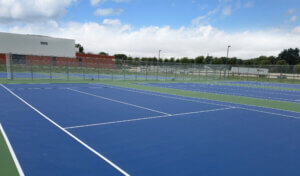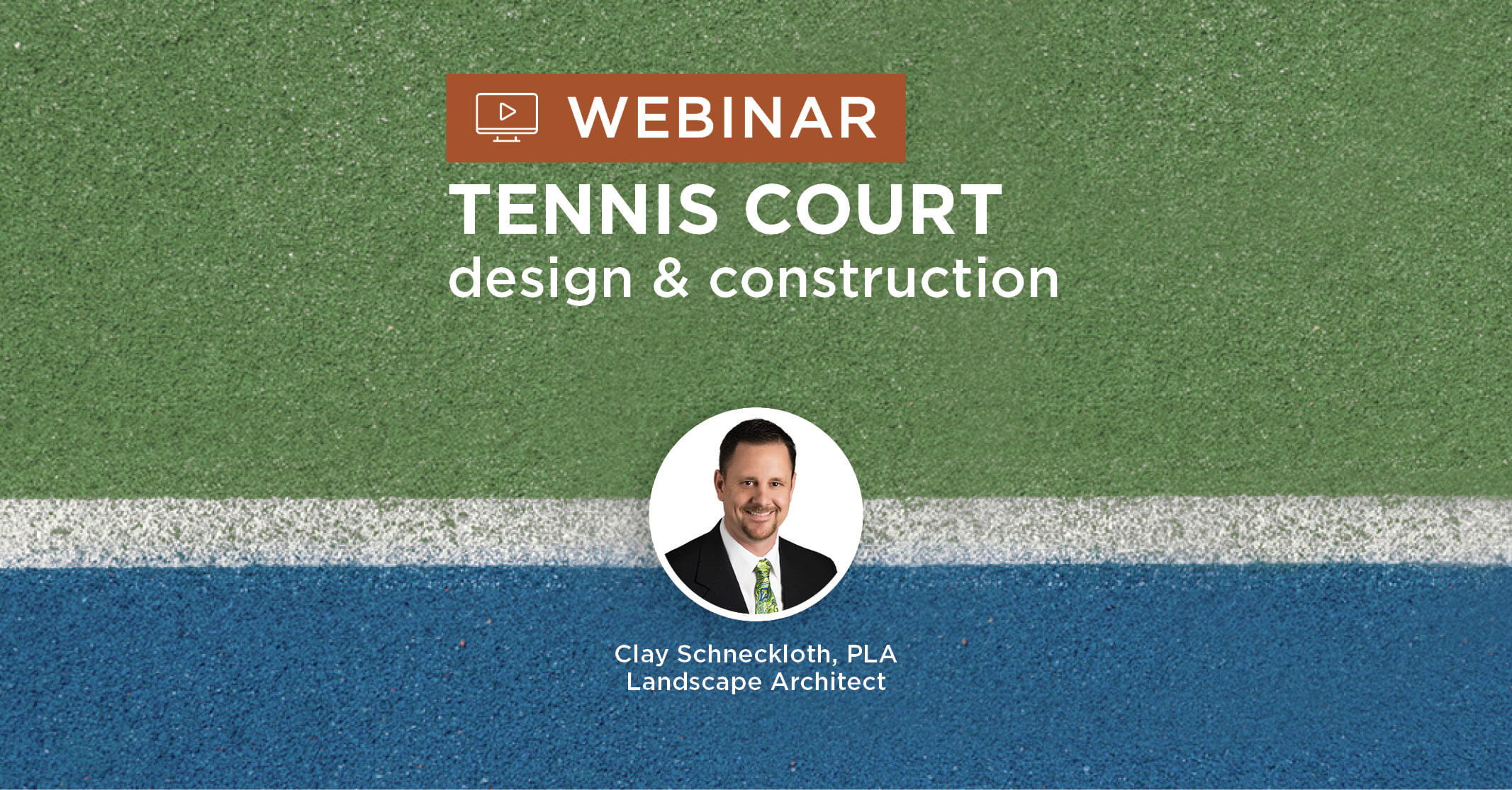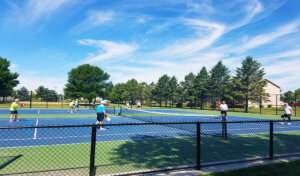Tennis Court Construction and Surfacing
By far, the most common issue with an asphalt tennis court design is pavement cracking. In spite of this, it continues to be frequently used on many tennis court surfaces due to the attractive price tag. Armed with this knowledge, Clay Schneckloth, Landscape Architect with Snyder & Associates, shares details on special design components, surface products, and proper construction scheduling for tennis courts.
Webinar Agenda
- Introduction (0:19)
- Overview of Tennis Court Surfacing Project (0:55)
- Tennis Court Surfacing is a Complete System (1:30)
- Cohesive Athletic Facility Design (2:07)
- Special Design Components
- Rock Subbase & Subdrain (2:53)
- Asphalt Mix Design (3:46)
- Surfacing Products (4:51)
- Asphalt vs. Post-Tension Concrete (7:27)
- Construction Methods (8:49)
- Construction Considerations – Schedule & Verification (9:58)
- Surface Repair Options (11:13)
- Maintenance (13:06)
Overview of Tennis Court Surfacing Project (0:19)
Alright, brand new tennis courts. They look amazing. They first get finished, everybody’s excited. Let’s get out there and start playing. But how do we get there? This is the first phone call that we see and receive is the cracks that are showing up on these courts. So we’ll get a phone call from the school or the city and say, we’ve got some courts, we’ve got some cracks that are showing up. Can you stop out, take a look, give us a talk on figuring out what’s what? What do we need to do next? We’ve been through these. We’ve seen these. There are all kinds of different scenarios that happen to tennis courts. So what we’re doing is we’re going to start to follow a process. So when we get out, we get these first initial phone calls, we start looking at existing analysis of what these courts are doing and start planning for what can we do to help your courts, whether it’s a brand new set of courts, rehabbing an existing set of courts or updating some portion of your existing courts. So we’ll start working with you on what those concepts are, start pulling together designs and then hopefully start moving forward with bidding and construction of these tennis courts.
Tennis Court Surfacing is a Complete System (1:30)

Determining subbase, subdrain and asphalt type are all important decisions when designing a tennis facility.
So from that process, we’ll start talking about the actual design of the tennis court surfacing itself. We’re going to concentrate on that part of it here today. The tennis court surfacing is a complete system. One thing that we need to make sure that we’re aware of is that it’s not just the surface paint that we’re seeing. It’s the subgrade, the subbase, the subdrain that’s associated with the asphalt mix that’s going to be placed, and then the surface thing on top of it. Those are all items that we need to be aware of. It’s not just one of those. All those work together as a complete system.
Cohesive Athletic Facility Design (2:07)
Other items that we’ll want to discuss when we’re meeting with you it’s just also like the court access. How are people getting there? Where are the spectators going to be sitting to view the matches? What type of slope are we having on the courts? What’s the surface drainage? We talked about that a little bit on the tracks too. We really don’t want a hillside draining onto our tennis courts. We’re going to look at what we have draining to this area because water is one of the main issues of what we’re trying to deal with these fluctuations of the courts and getting the cracks in there. What’s the wind like on the place that we’re going to be placing these courts? Is it on top of a hill and super windy? And then also lighting, sometimes it’s nice to be able to provide that amenity for a city or a school for being able to play in the evening.
Tennis Court Special Design Components (2:53)
Rock Subbase & Subdrain
So back to the actual product that the components of the tennis court surface there. We’re going to start with the rock subbase. Through various projects that we’ve worked on, we need to have this rock sub-base be able to be compacted, but we also need it to be drainable. We’ve worked with suppliers around the state on different types of modified subbase. The smaller rocks clog up the pores, and that subbase is not drainable, and that’s the issue. We want to get the water out of there so this subgrade doesn’t heave or swell and cause cracks in your surface. Because most of the courts that we’re doing are an asphalt mix or an asphalt design, and when the subgrade or subbase moves, that will reflect with a crack through the top. So that removal and getting rid of that subgrade water is key to making a successful project.
Asphalt Mix Design
The asphalt mix design. Over the years, there have been different options that we’ve looked at. A couple of the items that we’re starting to see that we are wanting to make you aware of is that there’s a chert or a shale rock material that’s showing up in some of the asphalt mixes. So we want to make sure you’re working with an asphalt supplier and also the quarries to verify that we’re getting a clean mix that we’re specifying. Iron pyrite is also a product that’s showing up in the asphalt mixes. We would alleviate that we specified a manufactured sand instead of a natural sand that has iron pyrite in it. The manufactured sand has eliminated the iron pyrite, which causes the rust volcanoes on your surface. The one pictured on the bottom right-hand photo there shows those rust iron volcanoes. That’s the iron pyrite that’s in the asphalt mix. So if you specify with the manufactured sand, you’re helping to alleviate some of those rust spots.
Surfacing Products (4:51)
One of the items that we’re also seeing and talking about when we’re working with suppliers are the surface shrink cracks. We’re seeing this on the very top surface of the asphalt. It’s happening with almost like a spider web type of crack. So we’re looking at different products to help alleviate cause, once that surface cracks that’ll reflect through your paint surface above. So what are our options to help alleviate some of the surface cracks from the asphalt? We’re finding that we’re looking at using a flexible acrylic resurfacer as part of our paint surface product. We used to specify just a standard acrylic resurfacer, but those shrink cracks were reflecting through it. By specifying a flexible one, it helps that scenario, keeping that crack from reflecting through there.
Our surfacing products, there are three main suppliers that we work with. Laykold, Plexipave, and SportMaster, all carry very similar products. All have similar characteristics for temperature sensitivity and also timing in putting them down. Timing in putting these down, we want to make sure that we have everything ready and our surfacing installed before October 1st. After October 1st, the weather is varying too much, and we’re not getting the nighttime temperatures that we’re needing to put down this top surface paint. And then, if we do it later in the season and the cold temperatures come in, there are cracks that would reflect through our surface there in, which we do not want. The asphalt, after we get it down, we want to make sure we have it down for 20 days before we start putting our surface product on.
One of the other main key things on the asphalt installation is that we are specifying a 0.8% cross slope on this. This is side to side, not end to end. So we start talking about the layout of our tennis courts, where they’re going to be. We need to consider how we’re going to get our surface water off of the courts themselves. So a 0.8% cross slope, side to side is what we anticipate and what we designed for. With this being that flat, 0.8% is really flat, there’s a great possibility of birdbaths when you’re doing a surface that flat. So you really need to work with your contractors on making sure we’re getting a good quality, making sure they’re paying attention to what they’re doing, and getting this surface installed at that flat of a rate. Some of those birdbaths can be fixed with a court patch binder after the asphalt’s been installed. But there’s only a certain depth that you can build that surface up to.
Asphalt vs. Post-Tension Concrete
There’s been a lot of questions about asphalt versus post-tension concrete tennis courts. A lot of the courts that we’ve worked with and currently in the past and also now are asphalt courts, but there have been more and more questions about post-tension. Post-Tension is a structural concrete slab with tension cables through it. The asphalt’s flexible, so the post-tension is going to allow you more resistance to movement and cracking, which is always been the issue with asphalt courts is the movement cracking that reflects through the surface there. The post-tension courts are more expensive courts. They are about one and a half times the cost of an asphalt court, so if cost is an item, a lot of times, we have to fall back to an asphalt type system.
The asphalt type system also needs regular maintenance to the surface. There are some crack and joint sealants that need to happen. Where in a post-tension concrete type system, there’s going to be less maintenance that’s going to be needed to the surface on it. So there are pluses and minuses to both. The post-tension is going to have a longer lifespan. There is a limited contractor availability on post-tension concrete tennis courts, there’s not many around that are able to install it, where there are quite a few asphalt contractors that are around and familiar that we’ve worked with that understand construction methods for asphalt type systems.
Construction Methods (8:49)
You can see in some of these photos here where we’re starting with the rock base in the top left-hand picture. Moving over the top right-hand picture, installing the asphalt. As you can see with the top right-hand picture, it takes big equipment. So we were talking about where we’re going to place these tennis courts. We need to make sure we have access to get the dump trucks in there fully loaded and the machinery to get in and out of there. So a lot of trucks are coming in and out of there. They’re going to cause an issue with the grass area. Maybe you’re trying to get to, or maybe it’s a parking lot that they’re crossing that we may have to look into working on or fixing after we get the tennis courts built. After we get the tennis courts asphalt down, we start working on placing the paint surface. We do need to wait that 20 days. Like I said before, after the asphalt’s down to, start doing the painting. It takes about two weeks to get that paint surface down. And then, as soon as they get that paint surface down, we like to try and recommend about 48 hours before you get out there and start playing on it as can see those people in the bottom right-hand picture there. So everybody’s excited. They want to get out and start playing.
Construction Considerations – Schedule & Verification (9:58)
A lot of these schedules are similar to the track projects and the synthetic turf projects. It’s a temperature-sensitive type project. We want to try and start construction in May. We want to make sure we have the asphalt down by September 1st. That gives us our 20 days time to cure. And then we can also get our two weeks of putting the fence in typically while it’s curing. And then two weeks of putting the surfacing on it. And that usually gets us finished by October 1st, so there’s a couple of time-sensitive dates there that we want to try and hit, for sure. We know this is a spring sport. We want to try and get in there after the spring activities and do it over the summer months.
Once we get into construction, there’s a lot of verifications that we need to make sure happen too. There’s a lot of different testing. We want to make sure we’re getting subgrade tested. We’re doing proof rolls. We want to have layout verified when it’s set up. There specific distances that we need to have both with a track and a tennis court, so making sure we’re having the layout set, that we need to have regulation size—specified product testing with all of our products. A lot of this stuff is showing up in a large barrel. We want to make sure we’re getting the quantity of the barrels that are supposed to be out there for this project.
Surface Repair Options (11:13)
As you can see from one of the first original pictures I showed you here, the crack repair. It’s something that we’re going to need to deal with and work on. There are many different options that we can talk about and work through here. It’s depending on the severity, but we’ll just want to make sure you understand that doing crack repair, it’s just providing some additional life to your system. The cracks will reappear. So you can see in the top right-hand corner we’re looking at doing a crack filler or joint filler. This is a maintenance item that should be looked at when we start talking about maintenance here a little bit later. If you’re having birdbaths, court patch binding, on the left side there, it’s a flowable product that you can help lift some of these birdbaths out of there.
If you’re getting into a repair of substantial size, there are many different fabric repair systems out there. The bottom right-hand corner shows a couple of different photos from Armor, it’s a flexible fabric type system that we can look into and talk with you about, and sometimes they get to a point where there’s some vertical deflection where it’s to a point where we need to talk about full depth repair or replacement of the tennis courts. I get a lot of calls about pinholes that show up on the surface, too, a lot of these pinholes are reflective of the surface below. The surface below, if it’s a course surface, it’s not a smooth surface like we had specified sometimes some of those pinholes will show up when you start putting on the paint surface above it. It also appears during hot weather applications. The water evaporates out of that surface a little bit quicker than it should and creates these pinholes. So it’s something that we need to be aware of during construction.
Maintenance (13:06)
Maintenance of these courts it’s an item that we would try to help you with and help push you. A lot of times, you get the new courts built, you walk away, don’t worry about them for a number of years. We do not recommend that. We’d like to have you get out there and walk the courts, start a regular maintenance program, contact us with questions, contact an appropriate contractor to come in and do filling of joints as needed but be proactive. Be aware of what’s going on on your courts. Jump on the issues before they become too bad, and we end up having to do a full replacement. You might be able to extend the life of your courts just a little bit longer.

Clay Schneckloth, PLA
Landscape ArchitectClay Schneckloth, PLA
Landscape ArchitectParks and Recreation Design, Sports Fields Design, Green Infrastructure and Native Plantings, Landscape Design

